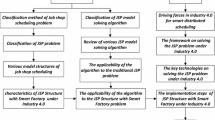Abstract
Scheduling problems have been studied extensively over the years. Broad ranges of focus areas exist, from optimization to heuristics, production planning to production sequencing, customized algorithms to general-purpose algorithms, and from simple machines to complex environments. In this research, a heuristic approach has been proposed to overcome the scheduling problem on a complex job shop found at a manufacturer of commercial building products. The research is aimed at sequencing production orders in near-real-time, primarily to minimize total tardiness, but also to reduce total setup time. A layered Shifting Bottleneck Procedure is employed, with the top layer determining release dates and due dates for individual jobs, and the bottom layer applying algorithms to individual work centers. The outcome of this research is a better production schedule than current methods with minimal computation cost. The proposed framework performs well and could be applied to other production areas.

Similar content being viewed by others
References
Adams J, Balas E, Zawack D (1988) The shifting bottleneck procedure for job shop scheduling. Manage Sci 34:391–401
Askin RG, Standridge CR (1993) Modeling and analysis of manufacturing systems. Wiley, New York
Balas E, Lancia G, Serafini P, Vazacopoulos A (1998) Job shop scheduling with deadlines. J Comb Optim 1:329–353
Balas E, Simonetti N (2001) Linear time dynamic-programming algorithms for new classes of restricted TSPs: a computational study. INFORMS J Comput 13(1):56–75
Balas E, Simonetti N, Vazacopoulos A (2008) Job shop scheduling with setup times, deadlines, and precedence constraints. J Sched 11:253–262
Balas E, Toth P (1983) Branch and bound methods for the traveling salesman problem. Management Science Research Report, No MSRR 488. Carnegie-Mellon University, Pittsburgh
Balas E, Vazacopoulos A (1998) Guided local search with shifting bottleneck for job shop scheduling. Manag Sci 44:262–275
Bean JC (1994) Genetic algorithms and random keys for sequencing and optimization. ORSA J Comput 6(2):154–160
Blackstone J (2013) APICS dictionary, Fourteenth edn. APICS, Chicago
Carpeneto G, Toth P (1980) Some new branching and bounding criteria for the asymmetric travelling salesman problem. Manag Sci 26(7):735–743
Chiang TC (2013) Enhancing rule-based scheduling in wafer fabrication facilities by evolutionary algorithms: Review and opportunity. Comput Ind Eng 64:524–535
Chiang TC, Cheng HC, Fu LC (2010) A memetic algorithm for minimizing total weighted tardiness on parallel batch machines with incompatible job families and dynamic job arrival. Comput Oper Res 37:2257–2269
Edmonds J, Karp RM (1972) Theoretical improvements in algorithmic efficiency for network flow problems. J Assoc Comput Mach 19(2):248–264
Fogel LJ, Owens AJ, Walsh MJ (1966) Artificial intelligence through simulated evolution. Wiley, New York
Graham RL, Lawler EL, Lenstra JK, Rinnooy Kan AHG (1979) Optimization and approximation in deterministic sequencing and scheduling: a survey. Ann Discrete Math 5:287–326
Graves S (1981) A review of production scheduling. Oper Res 29:646–675
Hall LA, Shmoys DB (1990) Jackson’s rule for single-machine scheduling: making a good heuristic better. Math Oper Res 17(1):22–35
Hanzálek Z, Šůcha P (2017) Time symmetry of resource constrained project scheduling with general temporal constraints and take-give resources. Ann Oper Res 248:209–237
Johnson DS, Gutin G, McGeoch LA, Yeo A, Zhang W, Zverovitch A (2002) The traveling salesman problem and its variations. Kluwer Academic Publishers, Dordrecht
Kanellakis PC, Papadimitriou CH (1980) Local search for the asymmetric traveling salesman problem. Oper Res 28(5):1086–1099
Karp RM (1979) A patching algorithm for the nonsymmetric traveling-salesman problem. SIAM J Comput 8(4):561–573
Karp RM, Steele JM (1985) Probabilistic analysis of heuristics. In: The traveling salesman problem. Wiley, New York, pp 181–205
Kashan AH, Karimi B, Jenabi M (2008) A hybrid genetic heuristic for scheduling parallel batch processing machines with arbitrary job sizes. Comput Oper Res 35:1084–1098
Kim YD, Joo BJ, Choi SY (2010) Scheduling wafer lots on diffusion machines in a semiconductor wafer fabrication facility. IEEE Trans Semicond Manuf 23(2):246–254
Koh SG, Koo PH, Kim DC, Hur WS (2005) Scheduling a single batch processing machine with arbitrary job sizes and incompatible job families. Int J Prod Econ 98:81–96
Lawler EL, Lenstra JK, Rinnooy Kan AHG, Shmoys D (1985) The traveling salesman problem: a guided tour to combinatorial optimization. Wiley, New York
Liu SQ, Kozan E (2012) A hybrid shifting bottleneck procedure algorithm for the parallel-machine job-shop scheduling problem. J Oper Res Soc 63:168–182
López-Ibáñez M, Blum C, Ohlmann JW, Thomas BW (2013) The travelling salesman problem with time windows: adapting algorithms from travel-time to makespan optimization. Appl Soft Comput 13:3806–3815
Malve S, Uzsoy R (2007) A genetic algorithm for minimizing maximum lateness on parallel identical batch processing machines with dynamic job arrivals and incompatible job families. Comput Oper Res 34:3016–3028
Méndez CA, Cerdá J, Grossmann IE, Harjunkoski I, Fahl M (2006) State-of-the-art review of optimization methods for short-term scheduling of batch processes. Comput Chem Eng 30:913–946
Mladenović N, Hansen P (1997) Variable neighborhood search. Comput Oper Res 24(11):1097–1100
Mönch L (2012) Design and implementation of a service-based scheduling component for complex manufacturing systems. In: Proceedings of the 14th international conference on enterprise information systems, pp 284–290
Mönch L, Drießel R (2005) A distributed shifting bottleneck heuristic for complex job shops. Comput Ind Eng 49:363–380
Mönch L, Fowler JW, Dauzère-Pérès S, Mason SJ, Rose O (2011) A survey of problems, solutions techniques, and future challenges in semiconductor manufacturing operations. J Sched 14:583–599
Phanden RK (2016) Multi agents approach for job shop scheduling problem using genetic algorithm and variable neighborhood search method. In: Proceedings of the 20th world multi-conference on systemics, cybernetics, and informatics, pp 275–278
Potts CN (1980) Analysis of a heuristic for one machine sequencing with release dates and delivery times. Oper Res 28(6):1436–1441
Ramacher R, Mönch L (2016) An automated negotiation approach to solve single machine scheduling problems with interfering job sets. Comput Ind Eng 99:318–329
Schutten JMJ, van de Velde SL, Zijm WHM (1996) Single-machine scheduling with release dates, due dates and family setup times. Manag Sci 42(8):1165–1174
Shen L, Mönch L, Buscher U (2014) A simultaneous and iterative approach for parallel machine scheduling with sequence-dependent family setups. J Sched 17:471–487
Sobeyko O, Mönch L (2015) Grouping genetic algorithms for solving single machine multiple orders per job scheduling problems. Ann Oper Res 235:709–739
Sobeyko O, Mönch L (2015) Heuristic approaches for scheduling jobs in large-scale flexible job shops. Comput Oper Res 68:97–109
Sourirajan K, Uzsoy R (2007) Hybrid decomposition heuristics for solving large-scale scheduling problems in semiconductor wafer fabrication. J Sched 10:41–65
Tan Y, Mönch L, Fowler JW (2014) A decomposition heuristic for a two-machine flow shop with batch processing. In: Proceedings of the 2014 winter simulation conference, pp. 2490–2501
Uzsoy R (1995) Scheduling batch processing machines with incompatible job families. Int J Prod Res 33(10):2685–2708
Wang CS, Uzsoy R (2002) A genetic algorithm to minimize maximum lateness on a batch processing machine. Comput Oper Res 29:1621–1640
Wright S (1932) The roles of mutation, inbreeding, crossbreeding, and selection in evolution. In: Proceedings of the sixth international congress on genetics, pp 356–366
Waschneck B, Altenmüller T, Bauernhansl T, Kyek A (2017) Production scheduling in complex job shops from an industry 4.0 perspective: a review and challenges in the semiconductor industry. CEUR Workshop Proceedings 1793
Yusof R, Khalid M, Hui GT, Yusof SM, Othman MF (2011) Solving job shop scheduling problem using a hybrid parallel micro genetic algorithm. Appl Soft Comput 11:5782–5792
Acknowledgements
The authors would like to acknowledge and thank Dr. Abhijit Gosavi from the Department of Engineering Management and Systems Engineering at Missouri University of Science and Technology for his valuable review and feedback.
Author information
Authors and Affiliations
Corresponding author
Additional information
Publisher's Note
Springer Nature remains neutral with regard to jurisdictional claims in published maps and institutional affiliations.
Rights and permissions
About this article
Cite this article
Cayo, P., Onal, S. A shifting bottleneck procedure with multiple objectives in a complex manufacturing environment. Prod. Eng. Res. Devel. 14, 177–190 (2020). https://doi.org/10.1007/s11740-019-00947-7
Received:
Accepted:
Published:
Issue Date:
DOI: https://doi.org/10.1007/s11740-019-00947-7




